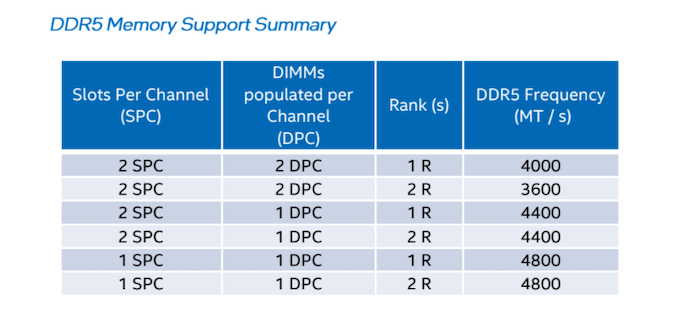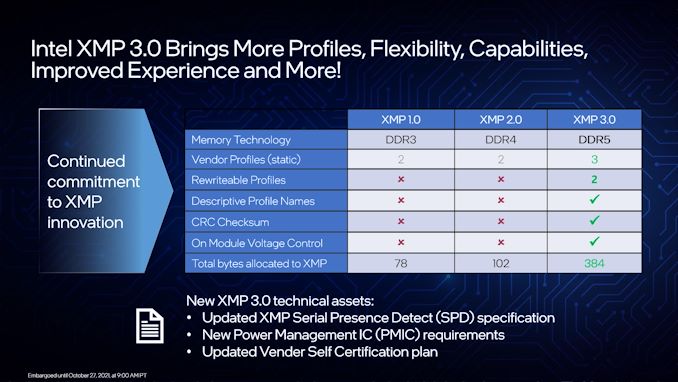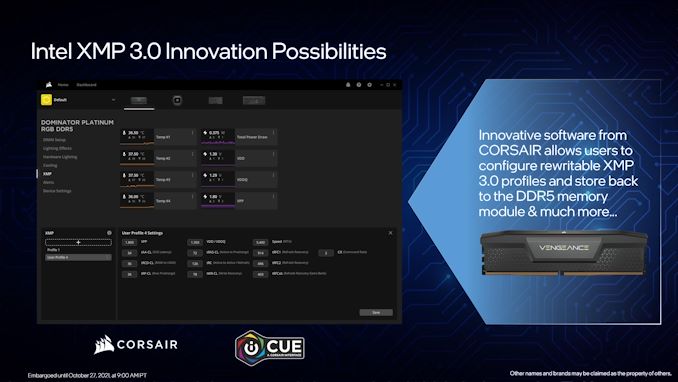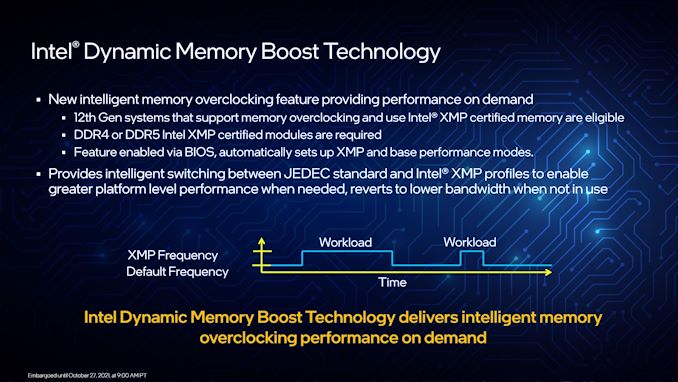Intel 12th Gen Core Alder Lake for Desktops: Top SKUs Only, Coming November 4th
by Dr. Ian Cutress on October 27, 2021 12:00 PM EST- Posted in
- CPUs
- Intel
- DDR4
- DDR5
- PCIe 5.0
- Alder Lake
- Intel 7
- 12th Gen Core
- Z690
Memory: Varies with Number of Modules
Inside each of the Alder Lake processors are memory controllers for both DDR5 and DDR4. Unlike previous generations, we’re unlikely to see motherboards supporting both types of memory. We understand that Intel has explicitly requested this – we didn’t see many retail combo boards in the DDR3/DDR4 era, so expect to see fewer this time around (although you can imagine someone will eventually do it). There is a slight technical reason too – DDR5 uses onboard power management, while DDR4 requires that from the motherboard, something which is hard to implement without wholly independent traces for both. If Intel is saying both cannot be done at the same time, then it’s likely that this is a unified DDR4+DDR5 controller that shares an amount of logic internally, but only one can be used at any one time.
Intel lists the specifications for its memory support as DDR4-3200 and DDR5-4800, and as always memory support is listed as conforming to the JEDEC implementations. This means Intel qualifies DDR4-3200 CL22, and anything above that is technically overclocking the CPU – it’s actually hard to find consumer memory at this speed these days. For DDR5, there are actually three specifications here:
| DDR5 JEDEC Specifications | |||||||
| AnandTech | Data Rate MT/s |
CL |
Peak BW GB/s |
Latency (ns) |
|||
| DDR5-4800 | A | 4800 | 34 | 34 | 34 | 38.40 | 14.17 |
| B | 40 | 40 | 40 | 16.67 | |||
| C | 42 | 42 | 42 | 17.50 | |||
We clarified with Intel that the processor supports all three, with the top being DDR5-4800A CL34. This is despite Intel shipping DDR5-4800B CL40 with their press kits, but I digress.
The thing with memory support is that it usually quoted for a specific number of modules installed into the system. In this case, Intel is quoting these numbers using one module per channel (technically a 64-bit channel, but more on that later), meaning that these are the supported speeds when two memory modules are supported. The official supported speed changes if you have more memory, double-sided memory, or dual rank memory.
We’ve seen this before – server processors are notorious for having slower support when more memory modules are installed. It turns out the more bandwidth you need, the harder it is to keep that speed with higher capacity memory. It was only until Intel’s 11th Gen Core products that the memory design supported DDR4-3200 regardless of configuration, because sometimes that’s how long it takes to optimize a memory controller. For Alder Lake, DDR4-3200 is also supported in any configuration, but DDR5 changes depending on the memory.
Intel shared this table with us.
If the motherboard has two memory slots total, then the maximum support is DDR5-4800 in any configuration.
If the motherboard has four memory slots total, then the maximum support is DDR5-4400 when two slots are filled with any memory.
If all four memory slots are filled, single rank memory will support up to DDR5-4000.
If all four memory slots are filled, dual-rank memory will support up to DDR5-3600.
So technically Intel listing memory support on Alder Lake as DDR5-4800 is a bit of a misdirection compared to previous launches. If we were to look at parity, two modules in a four-slot board, then really we’d be quoting DDR5-4400. Funnily enough, all of Intel’s benchmarks presented at this launch were run at DDR5-4400, as per specification. Kudos to the testing team to staying within those guidelines.
A side note here on memory channels as a whole. In the desktop space, we’re used to one memory module having memory for one 64-bit memory channel. That’s true for DDR4, DDR3, DDR2 etc, but the DDR5 specifications move to 32-bit memory channels. So while each DDR5 module is still using 64-bits of bandwidth, there are technically two 32-bit memory channels worth of memory on each module. This can create a little bit of confusion, because it means that Intel 12th Gen, while still a 128-bit memory interface as previous generations, it uses 4x 32-bit channels, not 2x 64-bit. Undoubtedly companies (even Intel) still call this dual-channel, as a channel is usually inferred to be a 64-bit interface.
There is no easy solution here. 2DPC (two modules per channel) doesn’t really mean much if technically channel there infers 64-bit but you’re running on a 2x32-bit channel system. Some users are calling a DDR5 module a ’channel’ with two 32-bit ‘sub-channels’, although that is more a twisting of reality, given that sub-channels are often something else in memory design. Because we’ve used the word ‘module’ to imply a 64-bit channel for so long, and because memory can be installed with more than one module per 64-bit channel, it’s actually a mess in English to find not only the correct words but also ones simple enough to not make the situation overly complex. Perhaps it’s time for some new words.
Memory: XMP 3.0 and Better SPD
One of the new features with DDR5 is the expansion of Intel’s eXtreme Memory Profile support. Now moving to XMP 3.0, it increases flexibility for both users and vendors by increasing the number of profiles per module, opening up for customization, and improving the overclocking experience.
Memory vendors when they ship the memory will embed in the memory firmware a series of specifications, known as SPDs. For standard memory running to JEDEC specifications, the module will likely contain SPD profiles relating to something slow for underlying support, and then up to what the memory chips were sold at – depending on the motherboard, the system then picks the JEDEC SPD profile that best fits the processor (I’ve seen a wild variety of implementation here, funnily enough.
XMP goes above and beyond traditional SPD support.
XMP 2.0 on DDR4 contains up to two additional SPD profiles with overclocked values. For example, a DDR4-4000 CL16 memory module might have three profiles total – one at 2133 CL15, one at 3200 CL22, and a third XMP profile at 4000 CL16. It is up to the user to then select that profile when in the BIOS or through additional software. If the module has two XMP profiles, perhaps one for latency and another for bandwidth, then this can be done in XMP 2.0.
The update to XMP 3.0 allows for five profiles, rather than two. Three of these profiles are memory module vendor locked, limited by whatever they come out of the factory at. The final two profiles can be used by the memory module vendor, but are re-writable by users in order to save overclocking settings. These profiles can also be named to be descriptive.
Intel states that this re-writing process is backed by a rigorous checksum support so users can’t brick their hardware. For most situations, that’s going to be reasonable, however if that security does get broken, it might be advised that if you buy second-hand DDR5 to erase those profiles and not use them. Just in case it overvolts the memory controller to 3 volts, or something.
Alongside more profiles, because DDR5 moves the power management for the module onto the module itself, if a memory vendor uses a ‘better than base’ solution then users can adjust various voltages and timings on a per-module basis.
Both the profile expansion and the updated voltage controls are also now exposed to the operating system in such a way that allows for better software implementation. Users with Corsair memory, for example, can use Corsair software to adjust the memory on the fly and monitor temperatures, power, voltages, and also keep track of how they fluctuate during overclocking, testing, or normal use. There is also another new feature, allowing users to adjust memory frequency on the fly, which has never been seen before. We’ll cover that in the next section.
On a more ecosystem level, we confirmed with Intel that XMP 3.0 is a self-certification procedure at memory vendors, with no additional licensing costs to the vendors.
Memory Gets Turbo: Dynamic Memory Boost
One of the persistent features with memory over the years is that when you have settings saved in the BIOS, they are ‘trained’ (tested to work) when the system boots up, and then that’s what you have for the whole time that the system is turned on. It never slows down, it never duty cycles to reduce power – it has been very consistent for a long time.
With Intel’s Z690 boards and 12th Gen Core Alder Lake processors, that changes. Much like processors and graphics have had idle states and turbo states for generations, memory now gets it as well.
This first-generation technology is basic, but a start. A 12th Gen system, as long as it runs DDR4 or DDR5 memory with XMP, can define two of the onboard SPD profiles – one as the base, and one as the turbo. Usually the base profile is one of the immutable JEDEC profiles, and the turbo is an XMP profile. But when activated, the system is able to switch on the fly between the two, activating when a workload is initiated for higher performance, and supposedly better idle efficiency.
There are a few thoughts or questions on this worth noting:
#1: It works on DDR4? Intel says yes. This makes it sound like this is more of a software/firmware innovation than a hardware innovation, or it requires the right hardware on the CPU at least. No doubt if it works, it will become ubiquitous.
#2: Isn’t power efficiency really for benchmarks and laptops? I agree with this one, and expect it to be more of a highlighted feature when Alder Lake comes to laptops and notebooks. That being said, most notebook DRAM is JEDEC anyway, so it might open the doors for better-overclocked notebook memory if it can retain the battery life of a base JEDEC profile. Either that, or notebook memory will use a fast JEDEC profile in operation, then move to a more efficient but slower JEDEC profile on idle to save power.
#3: Doesn’t this introduce instability? Perhaps, but if it’s handled in the same way CPU turbo can be, then it shouldn’t be an issue.
In the same way we look to measure how CPU frequency ramps up from a performance request, we will have to look into tools to measure the same thing on memory, especially if more than a simple base/turbo system is developed for future use.














395 Comments
View All Comments
DigitalFreak - Wednesday, October 27, 2021 - link
Fanboi says what?Kangal - Friday, October 29, 2021 - link
What?But to get a little serious, I don't think Intel is going to win with their big.LITTLE architecture. I feel like ARM has a huge lead on the 15W (or less) demographic. So it would make sense for x86 designers to double-down on their performance lead in the higher thermal envelope. That's what AMD is (seemingly) going for with its focus on lower-latency Infinity Fabric, +5nm node to clock higher, and their 3D-Stacking of Cache. Not to mention all the help from DDR5, Pcie 5, nVme, Wifi 6 etc etc.
Intel's approach will win them back the Laptop segment, but they won't be winning the tablet segment back from ARM. And even the Gaming Laptop segment won't be an outright victory against AMD's offerings, not to mention the New MacBook Pros. If anything, Intel should have capitalised on their Atom efficiency cores, and do little.BIG computing in like 2018.
Servers is a position where Intel may see improvements. But it's still in favour of AMD for now and the near future. The bigger threat comes from next-gen ARM-servers. I doubt anything from the left-field will come, RISC-V is still a paperlaunch/niche for the next few years.
So while I think Intel is (FINALLY) becoming competitive against AMD, I don't think they have enough to go on. Their node is still inferior. Their Xe-Graphics are still inferior to RDNA-2. And they still lag behind AMD's Cores when you factor in Infinity-Fabric and 3D-Cache. Not to mention that the system/kernel is not quiet optimised yet (let alone individual programs) when thinking about Windows11.
For now, we have to choose from:
Android, iOS, macOS, Windows
RISC-V, ARM, Apple-ARM, Intel, AMD.
ARM-Mali, PowerVR, Apple-Graphics, Nvidia, AMD RDNA.
Silver5urfer - Thursday, October 28, 2021 - link
What is this fanboy junk...sigh.ADL demands Windows 11 POS, you want to shill for the HW which demands installing a strictly mobile junk copied OS with zero respect to computing factor on top where they are saying VBS is mandatory on all OEM machines and purposefully nuked AMD L3 performance ?
I have a positive opinion on this ADL but it has insane changes, like Intel ITD drama who wants to endure that band aid solution of Intel with 2 layer system in between the OS and CPU. On top the major issue being socket longevity. How long this socket will retain it's value and will Intel release another Z790 next year ? No idea.
Now for your AMD bashing, Zen 3 wiped the floor with 2 generations of processors yeah they have bugs while OCing and DRAM tuning, but if you run at stock no issues and performs very well competitively. And for the ADL performance, it's honestly a joke. Because ADL has small trash cores since Intel wants to sell more BGA junk and they cannot beat the performance with more cores due to 10nm heat.
Raptor Joke lol so ADL CPU is going to be EOLed under a year lmao, just like 11900K ? 2 CPUs in succession. While 10900K still stands strong. That's Intel for you. Meanwhile AMD's Zen 3 is now ready for 2022 action as well with AM4 and 3D V Cache. Keep using the yearly socket refresh and chipset refresh and CPU refresh while coming here and spout nonsensical load.
Finally pay up DDR5 tax and premium premature trash DDR5 quality, by 2023-2024 DDR5 will be matured and all ADL buyers will weep hard.
Now for the closure. Zen 4 is going to steamroll over Raptor Joke, 100% garunteed. Do you think these companies operate without knowing what their competitor is doing ? they operate 2 years ahead of cycle internally. Plus AM4 experience is very important for AMD to fix the bugs from Platform to CPU. Ultimately they cleared out saying we are not using joker big little design. A full far Zen 4, massive price increase is also coming from them, the IPC boost and the ST SMT performance will send fanboys to darkages.
Silver5urfer - Thursday, October 28, 2021 - link
I forgot to post important thing, be happy that you have AMD as competition else Intel would have been selling you 4C CPUs even in 2021 and AMD is pushing x86 to next level, if that design dies or stagnates PC will die. Keep the x86 alive if you want to own a computer not a consumable garbage ARM product.MaxIT - Thursday, October 28, 2021 - link
That works both ways: AMD dominion is not welcomed in the same way. Did you see what AMD did with prices ? AMD and Intel are the same: when they think they are above competitors, they start taxing customers. Let them fight to prevail: we customers will be the winnersQasar - Thursday, October 28, 2021 - link
" Did you see what AMD did with prices ? " you referring to the $50 price increase between zen 2 and 3 ? 50 bucks is nothing, compared to how much intel kept raising their prices over the years before zen 1 was released. but yet, very few complained about that.Oxford Guy - Friday, October 29, 2021 - link
That $50 is a response to the inflation that has been happening from all of the Covid money printing.mode_13h - Friday, October 29, 2021 - link
It's not only money-printing. There are legit shortages due to outbreaks in factories, and worker-shortages in certain sectors.I suspect one reason for the trucker shortage, in the US, is that truck drivers tend to be older and overweight, which are both risk factors for complications from Covid-19 (which the nature of their job also increased their exposure towards). So, I truly wonder how much the US truck driver shortage is due to drivers unable to continue performing their duties due to complications (or death).
Spunjji - Friday, October 29, 2021 - link
@mode_13h - It's a good point. A lot of chatter about the effects of COVID seems to ignore how many people more than usual died. It's not world-war levels of death, but systems subject to stress have to eat into margins to cope, and a lot of the world's financial and supply-chain systems were already under stress from tariffs and sustained economic strife when COVID hit - so there weren't a lot of margins left.mode_13h - Saturday, October 30, 2021 - link
@Spunjji a lot more people have long-term effects from Covid-19 than the ones who died. Death is just the worst outcome, but there are many people unable to function at the same level as before. And I'm not only talking about "long Covid", where the immune system seems to be stuck in an overstimulated state, but other sorts of cardiovascular and organ damage it can cause.